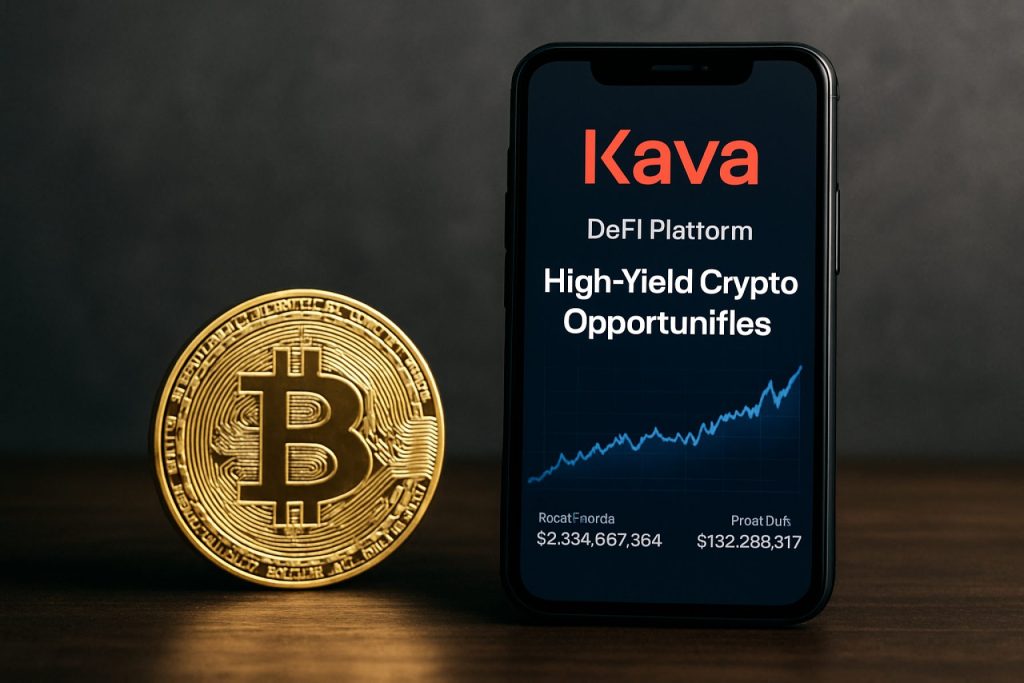
Discover the Power of Kava DeFi Platform: A Comprehensive Guide to Next-Gen Decentralized Finance. Explore How Kava is Revolutionizing Yield, Security, and Interoperability in the Crypto Space.
- Introduction to Kava DeFi Platform
- Core Features and Architecture
- Supported Assets and Interoperability
- Yield Farming and Staking Opportunities
- Security Protocols and Risk Management
- Kava Token (KAVA): Utility and Economics
- Partnerships and Ecosystem Growth
- User Experience and Platform Accessibility
- Roadmap and Future Developments
- Conclusion: Kava’s Impact on the DeFi Landscape
- Sources & References
Introduction to Kava DeFi Platform
The Kava DeFi Platform is a decentralized finance (DeFi) protocol designed to provide users with a suite of financial services, including lending, borrowing, and stablecoin issuance, all secured by blockchain technology. Built on the Cosmos SDK, Kava leverages a unique cross-chain architecture, enabling interoperability with assets from multiple blockchains such as Bitcoin, Ethereum, and Binance Chain. This cross-chain capability distinguishes Kava from many other DeFi platforms that are typically limited to a single blockchain ecosystem.
At its core, Kava operates as a decentralized lending platform where users can collateralize their digital assets to mint USDX, Kava’s native stablecoin. This mechanism allows users to unlock liquidity without selling their assets, a feature particularly valuable in volatile markets. The platform is governed by the KAVA token, which is used for voting on protocol upgrades, parameter changes, and other governance decisions, ensuring that the community has a direct say in the platform’s evolution.
Kava’s robust security model is underpinned by a network of validators who maintain consensus and validate transactions, utilizing a proof-of-stake (PoS) mechanism. The platform also integrates with a variety of DeFi applications and protocols, expanding its utility and reach within the broader crypto ecosystem. By focusing on interoperability, security, and community governance, Kava aims to provide a comprehensive and accessible DeFi experience for users across different blockchain networks. For more detailed information, visit the Kava Labs official website.
Core Features and Architecture
The Kava DeFi Platform distinguishes itself through a robust set of core features and a unique architecture designed to maximize interoperability, scalability, and security. At its foundation, Kava utilizes the Cosmos SDK, enabling it to leverage the Cosmos ecosystem’s Inter-Blockchain Communication (IBC) protocol. This architecture allows Kava to seamlessly connect with a wide array of blockchains, facilitating cross-chain asset transfers and expanding the platform’s utility beyond a single network Cosmos Network.
A central feature of Kava is its multi-asset collateralized debt position (CDP) system. Users can deposit a variety of digital assets—including BTC, XRP, BNB, and others—as collateral to mint Kava’s native stablecoin, USDX. This mechanism not only provides users with liquidity but also supports a decentralized, over-collateralized lending environment Kava Labs.
Kava’s architecture incorporates a dual-token model: KAVA, the governance and staking token, and USDX, the stablecoin. KAVA holders participate in protocol governance, voting on proposals and parameter changes, while also securing the network through staking. The platform’s modular design allows for the integration of new assets and financial products, supporting continuous innovation and adaptability.
Security is further enhanced through a decentralized validator set, which processes transactions and maintains consensus. The use of the Tendermint consensus engine ensures fast finality and resistance to common blockchain attacks. Collectively, these features position Kava as a versatile and secure DeFi platform capable of supporting a wide range of decentralized financial services Kava Documentation.
Supported Assets and Interoperability
A core strength of the Kava DeFi Platform lies in its robust support for a wide range of digital assets and its advanced interoperability features. Kava was designed as a cross-chain DeFi hub, enabling users to interact with assets from multiple blockchains within a single, unified ecosystem. Initially, Kava focused on supporting major cryptocurrencies such as Bitcoin (BTC), Ethereum (ETH), and Binance Coin (BNB), allowing users to collateralize these assets to mint Kava’s native stablecoin, USDX. Over time, the platform has expanded its asset support to include a broader array of tokens, including Cosmos-based assets and other ERC-20 tokens, further enhancing its utility and appeal to a diverse user base Kava Labs.
Interoperability is achieved through Kava’s integration with the Cosmos SDK and the Inter-Blockchain Communication (IBC) protocol. This architecture allows seamless asset transfers and data exchange between Kava and other IBC-enabled blockchains, such as Cosmos Hub and Osmosis. As a result, users can leverage liquidity and DeFi services across multiple networks without the need for centralized exchanges or complex bridging solutions. Additionally, Kava’s support for Ethereum Virtual Machine (EVM) compatibility enables developers to deploy Ethereum-native smart contracts and dApps on the Kava platform, further bridging the gap between the Cosmos and Ethereum ecosystems Kava Blog.
This multi-chain approach not only increases the number of supported assets but also positions Kava as a key player in the broader DeFi landscape, fostering greater liquidity, composability, and user choice across blockchain networks.
Yield Farming and Staking Opportunities
Kava DeFi Platform offers a robust suite of yield farming and staking opportunities designed to attract both retail and institutional participants seeking to maximize returns on their digital assets. Through its dual-chain architecture, which integrates the Ethereum and Cosmos ecosystems, Kava enables users to access a wide range of decentralized finance (DeFi) protocols and liquidity pools. Yield farming on Kava typically involves providing liquidity to various pools, such as those on the Kava Swap decentralized exchange, in return for rewards paid in KAVA tokens or other supported assets. These incentives are structured to encourage deep liquidity and active participation, which in turn enhances the platform’s overall efficiency and trading volume.
Staking is another core feature of the Kava ecosystem. Users can delegate their KAVA tokens to validators, supporting the network’s security and consensus while earning staking rewards. The platform’s staking mechanism is designed to be user-friendly, with flexible lock-up periods and competitive annual percentage yields (APYs). Additionally, Kava periodically introduces special staking programs and liquidity mining campaigns, offering bonus rewards or governance tokens to further incentivize participation.
Kava’s approach to yield farming and staking is underpinned by a strong emphasis on security, transparency, and cross-chain compatibility. The platform regularly undergoes third-party audits and implements rigorous risk management protocols to protect user funds. By bridging assets and liquidity across multiple blockchains, Kava provides users with diversified opportunities to earn passive income while contributing to the growth and resilience of the DeFi ecosystem. For more details on current opportunities and program specifics, users can refer to the Kava Official Website and the Kava Documentation.
Security Protocols and Risk Management
Security protocols and risk management are foundational to the Kava DeFi Platform’s architecture, reflecting the high-stakes environment of decentralized finance. Kava employs a multi-layered security approach, beginning with rigorous smart contract audits conducted by reputable third-party firms to identify and mitigate vulnerabilities before deployment. These audits are publicly accessible, fostering transparency and community trust. Additionally, Kava utilizes formal verification methods for critical codebases, mathematically proving the correctness of smart contracts and reducing the risk of exploits.
To further safeguard user assets, Kava implements a robust collateralization mechanism. All loans and stablecoin issuances on the platform are over-collateralized, meaning users must deposit assets exceeding the value of their borrowings. This design helps protect the protocol against market volatility and under-collateralization risks. Automated liquidation systems are in place to swiftly manage positions that fall below required collateral ratios, minimizing systemic risk and ensuring platform solvency.
Kava’s risk management framework also includes continuous monitoring and real-time analytics, enabling rapid detection of abnormal activity or potential threats. The platform maintains a bug bounty program, incentivizing ethical hackers to report vulnerabilities responsibly. Furthermore, Kava’s governance model allows token holders to propose and vote on protocol upgrades, including security enhancements, ensuring adaptive and community-driven risk management.
These comprehensive measures, combined with transparent communication and regular security updates, position Kava as a resilient and trustworthy DeFi platform. For more details on Kava’s security practices, refer to the Kava Security page and the Kava Documentation.
Kava Token (KAVA): Utility and Economics
The Kava token (KAVA) is central to the functioning and governance of the Kava DeFi Platform, serving multiple roles that underpin the ecosystem’s security, stability, and growth. As a native asset, KAVA is primarily used for governance, allowing holders to propose and vote on key protocol upgrades, parameter changes, and community initiatives. This decentralized governance model ensures that the platform evolves in line with the interests of its stakeholders, fostering transparency and adaptability Kava Labs.
KAVA also acts as a staking token, securing the network through a proof-of-stake consensus mechanism. Validators and delegators stake KAVA to participate in block production and transaction validation, earning rewards in return. This staking process not only incentivizes network participation but also enhances the platform’s security and resilience against attacks Kava Documentation.
Economically, KAVA is integral to the platform’s stability mechanisms. It is used as a reserve asset to back the issuance of Kava’s stablecoins and to absorb system debt during periods of market volatility. In the event of under-collateralization, KAVA can be minted and auctioned to recapitalize the system, ensuring the solvency of the protocol Kava Labs Blog.
Additionally, KAVA is distributed as an incentive to users who supply liquidity or participate in various DeFi services on the platform, driving user engagement and ecosystem growth. This multifaceted utility positions KAVA as a foundational asset within the Kava DeFi Platform, aligning economic incentives with network security and governance.
Partnerships and Ecosystem Growth
The Kava DeFi Platform has strategically prioritized partnerships and ecosystem growth as core drivers of its expansion and adoption. By fostering collaborations with leading blockchain projects, infrastructure providers, and institutional players, Kava has positioned itself as a cross-chain hub for decentralized finance. Notably, Kava’s integration with the Cosmos Network enables seamless interoperability with a wide array of blockchains, allowing assets and data to flow freely across different ecosystems. This interoperability is further enhanced by Kava’s support for the Inter-Blockchain Communication (IBC) protocol, which facilitates secure and efficient cross-chain transactions.
Kava’s ecosystem growth is also propelled by partnerships with major stablecoin issuers and liquidity providers. For example, the platform supports USDC and USDT, two of the most widely used stablecoins, thereby attracting a broader user base and increasing liquidity. Additionally, Kava collaborates with projects such as Chainlink Labs to integrate decentralized oracles, ensuring reliable and tamper-proof price feeds for its lending and borrowing protocols.
To further stimulate ecosystem growth, Kava has launched grant programs and developer incentives, encouraging the creation of new DeFi applications and services on its platform. These initiatives, combined with its robust technical infrastructure and active community engagement, have contributed to a vibrant and expanding DeFi ecosystem. As a result, Kava continues to attract new partners and users, reinforcing its position as a key player in the multi-chain DeFi landscape.
User Experience and Platform Accessibility
The Kava DeFi Platform places significant emphasis on user experience and accessibility, aiming to bridge the gap between complex decentralized finance protocols and mainstream adoption. The platform features a streamlined, intuitive interface that allows users to interact with its suite of DeFi products—including lending, borrowing, and staking—without requiring advanced technical knowledge. Kava’s dashboard consolidates key functions, providing clear navigation and real-time data on assets, yields, and collateralization ratios, which helps users make informed decisions efficiently.
Accessibility is further enhanced by Kava’s support for multiple blockchains through its use of the Cosmos SDK and Inter-Blockchain Communication (IBC) protocol. This interoperability allows users to deposit and utilize assets from various chains, such as Bitcoin, Ethereum, and Binance Smart Chain, directly within the Kava ecosystem. The platform also offers a non-custodial experience, ensuring users retain control over their private keys and funds at all times, which is a critical aspect of DeFi security and trust.
To lower entry barriers, Kava provides comprehensive documentation, tutorials, and community support, making it easier for both novice and experienced users to participate. The platform’s commitment to accessibility is evident in its ongoing efforts to reduce transaction fees and improve network scalability, ensuring a smooth experience even during periods of high demand. These features collectively position Kava as a user-centric DeFi platform, striving to make decentralized finance more approachable and inclusive for a global audience (Kava Labs, Kava Documentation).
Roadmap and Future Developments
The Kava DeFi Platform has outlined an ambitious roadmap aimed at enhancing its position as a leading cross-chain decentralized finance hub. In recent updates, the Kava team has focused on expanding interoperability, scalability, and developer accessibility. A key milestone is the integration of Ethereum Virtual Machine (EVM) compatibility, which allows Ethereum-based assets and decentralized applications (dApps) to operate seamlessly on Kava. This move is expected to attract a broader developer community and increase the diversity of DeFi products available on the platform. Additionally, the roadmap includes further enhancements to the Kava Network’s modular architecture, enabling more efficient upgrades and the addition of new features without disrupting existing services.
Looking ahead, Kava plans to introduce advanced governance mechanisms, empowering the community to have a more direct role in protocol upgrades and treasury management. The platform is also prioritizing the development of liquid staking solutions and new collateral types, which will expand the utility of the Kava ecosystem and provide users with more options for yield generation. Strategic partnerships with other blockchain networks and DeFi protocols are in progress, aiming to foster greater liquidity and cross-chain asset movement. The Kava team regularly publishes detailed progress reports and future plans, ensuring transparency and community engagement throughout the development process (Kava Labs). As the DeFi landscape evolves, Kava’s roadmap reflects a commitment to innovation, security, and user empowerment.
Conclusion: Kava’s Impact on the DeFi Landscape
Kava has established itself as a significant player in the decentralized finance (DeFi) ecosystem by offering a robust, interoperable platform that bridges the gap between various blockchain networks. Its unique architecture, which combines the security of the Cosmos SDK with Ethereum Virtual Machine (EVM) compatibility, enables developers and users to access a wide range of DeFi services, including lending, borrowing, and yield farming, all within a single, unified environment. This interoperability not only enhances liquidity but also fosters innovation by allowing assets and applications to move seamlessly across chains.
The platform’s emphasis on scalability and security has attracted a growing community of developers and users, contributing to the expansion of the DeFi sector as a whole. By supporting both Cosmos and Ethereum ecosystems, Kava lowers the barriers to entry for new projects and encourages cross-chain collaboration, which is essential for the maturation of decentralized finance. Furthermore, Kava’s governance model, powered by its native KAVA token, ensures that the community has a direct say in the platform’s evolution, promoting transparency and decentralization.
In summary, Kava’s innovative approach to interoperability, security, and community-driven governance positions it as a catalyst for the next phase of DeFi growth. Its ongoing development and strategic partnerships are likely to further solidify its role as a foundational layer in the multi-chain DeFi landscape, driving greater adoption and utility for decentralized financial services worldwide (Kava Labs).
Sources & References
https://youtube.com/watch?v=jMPyCz_3HkM



